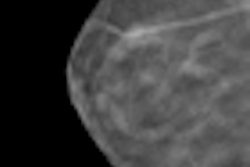The potential use of digital breast tomosynthesis (DBT) for screening mammography has been in question due to the modality's higher radiation dose. But a new study in the April issue of Radiology offers several scenarios in which DBT dose could ultimately be lower than that of two-view full-field digital mammography (FFDM).
Ioannis Sechopoulos, PhD, and colleague Steve Si Jia Feng of Emory University School of Medicine compared radiation dose from a commercially available DBT system operating in both 3D and conventional 2D modes in breast phantoms. They found that DBT dose could be comparable to that of FFDM for denser breasts. In addition, even though DBT's dose equivalence receded at lower breast densities, the modality could still offer lower overall dose if it reduces recall rates (Radiology, April 2012, Vol. 263:1, pp. 35-42).
Sechopoulos and Feng used breast phantoms for the study, which they imaged with the Selenia Dimensions system (Hologic) in both DBT (3D) and FFDM (2D) modes. They compared radiation dose levels between modes for several kinds of breast thicknesses, and also compared the results to standards set by the Mammography Quality Standards Act (MQSA) and to levels recorded in the landmark Digital Mammographic Imaging Screening Trial (DMIST).
"We wanted to get an idea of how much radiation dose would be used with both imaging modalities for breasts of varying sizes and glandular compositions," Sechopoulos told AuntMinnie.com.
For an "average" breast with a compressed thickness of 5 cm and a 50% glandular fraction, a single craniocaudal view with the DBT system (that is, one full tomosynthesis acquisition in one view) resulted in a mean glandular dose of 1.3 mGy, only 8% higher than the 1.2 mGy average dose on the FFDM system. A combined 2D/3D study taken during the same breast compression produced a dose of 2.5 mGy.
The dose difference grew wider in thicker breasts, however. In the phantom representing breasts 6-cm thick and with 14% glandular fraction, DBT produced a mean glandular dose of 2.12 mGy, which was 83% higher than the 1.16 mGy for FFDM.
Despite the higher dose at the greater breast thicknesses, the 2D/3D study at the 6-cm thickness still had a lower dose, at 2.5 mGy, than the limit of 3 mGy for a single-view conventional study set by MQSA, the authors noted. The level was also in the middle of the range of 2.06 mGy to 3.01 mGy reported in the DMIST study.
"The five centimeter thick, 50% dense breast characterization has been used as the definition of an 'average' breast for over 30 years," Sechopoulos said. "However, recent studies have pegged the average thickness closer to six centimeters, and density between 15% to 20%. This is why we looked at both."
Other researchers are examining whether a single view from the multiple projections acquired during a DBT study could be used in place of a two-view 2D FFDM exam. If this happens, this could result in a mean glandular dose savings, according to Sechopoulos and Feng.
What's more, if screening DBT reduces the recall rate, as early clinical studies suggest, there could be an even greater reduction in population-based radiation dose due to fewer diagnostic workup exams, which often require the acquisition of four to six additional views, they wrote.
"I would not be surprised if [fusion machines like this one] are the transition step between full-field digital mammography and DBT," Sechopoulos told AuntMinnie.com. "It may take a while, but [using DBT to screen for breast cancer] is coming."



















